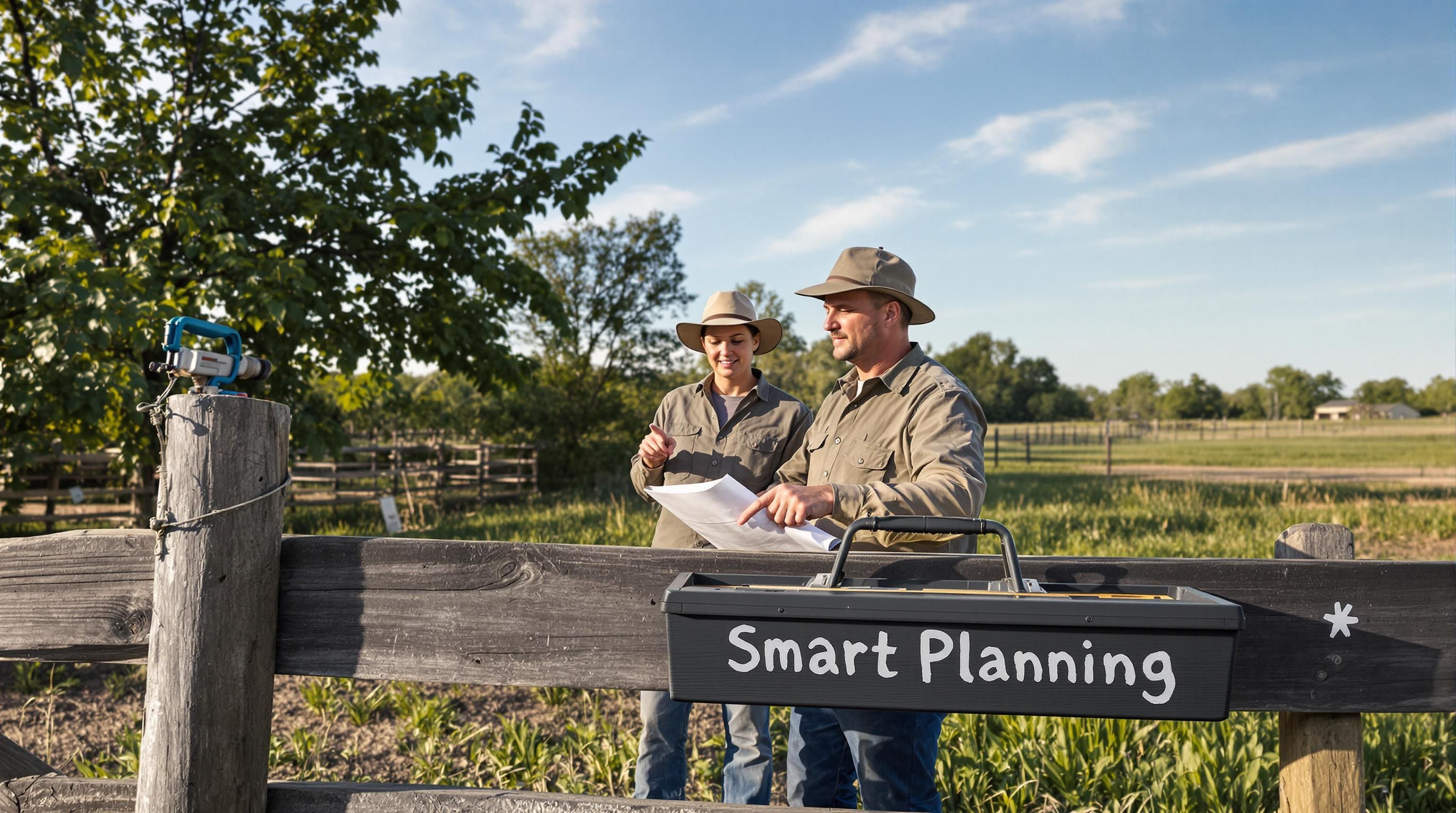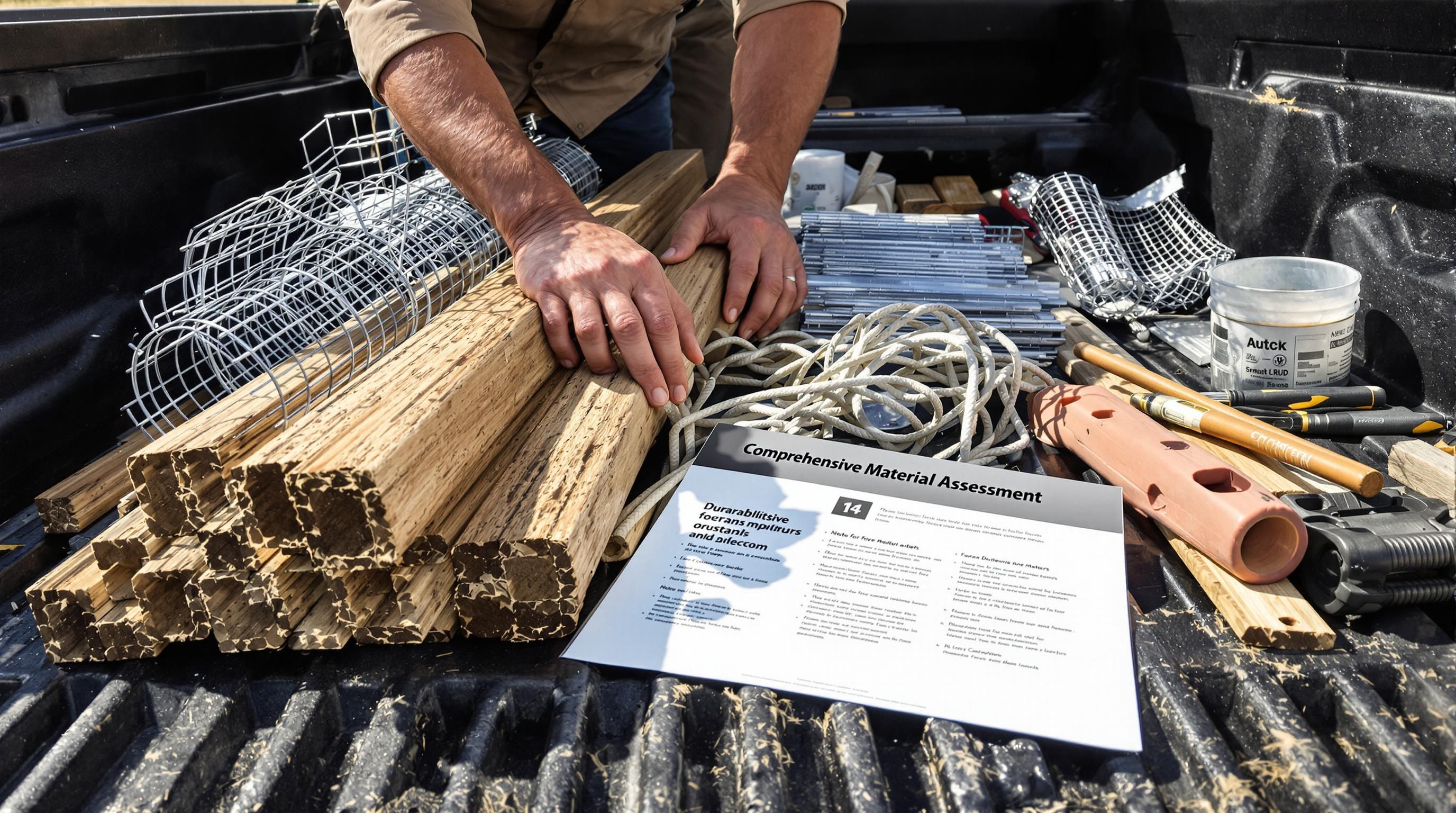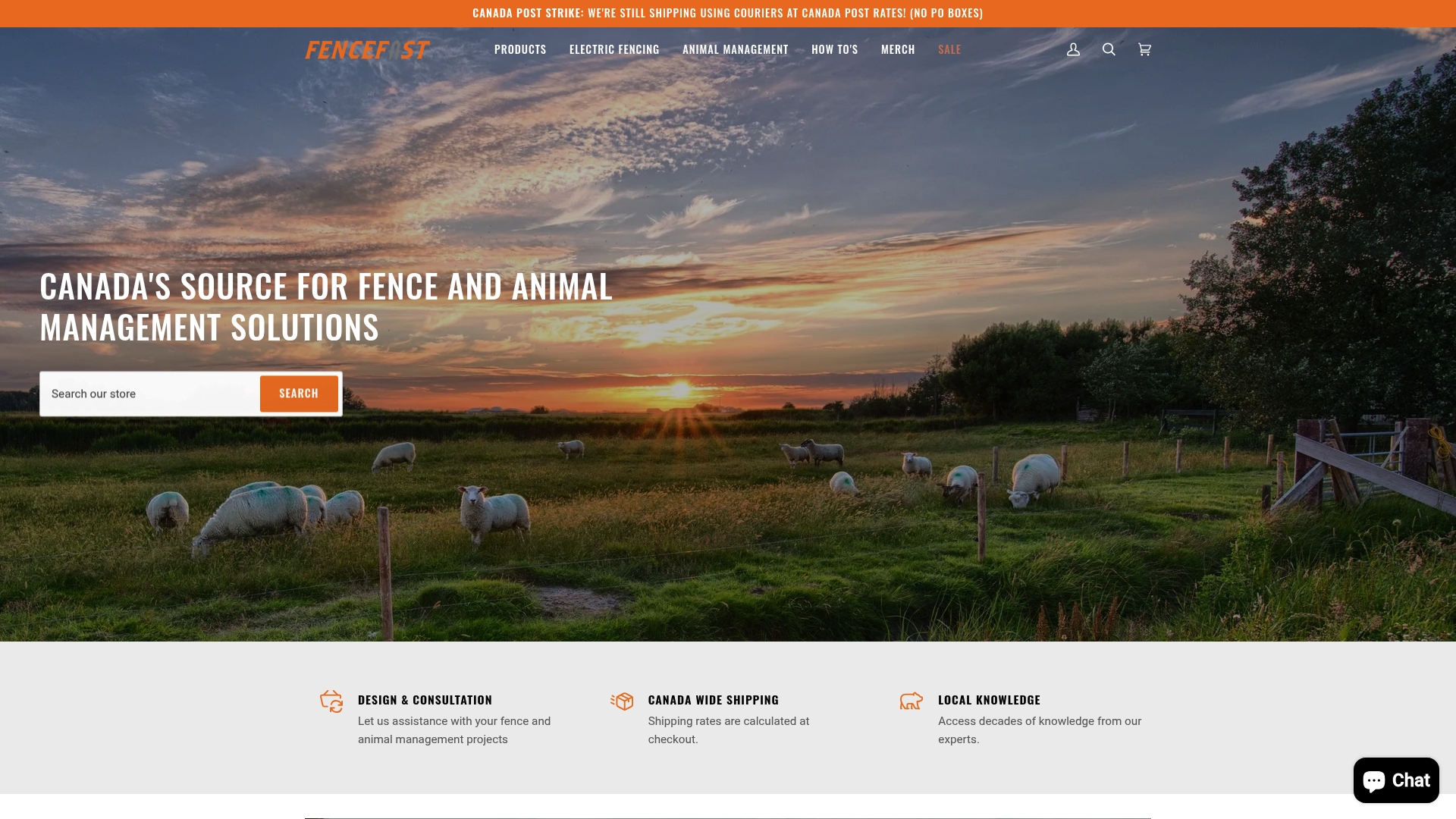
Building a fence might sound like a simple weekend project for rural properties and yet, overlooked details can turn it into an expensive headache. Most people are shocked to learn that nearly 80 percent of boundary disputes start with poorly placed fences, costing thousands to resolve. The real secret is that careful planning and the right materials do more than save money—they protect your land and keep neighbor drama at bay.
Table of Contents
- Planning And Preparing For Fence Installation
- Choosing Fence Types And Essential Materials
- Step-By-Step Fence Building Instructions
- Maintenance Tips And Tools For Long-Lasting Fences
Quick Summary
| Takeaway | Explanation |
|---|---|
| Conduct a thorough property assessment | Verify boundary lines and evaluate terrain before starting your fence project to avoid legal disputes and installation challenges. |
| Choose materials based on specific needs | Select the right fencing materials based on livestock type and environmental conditions to ensure durability and effectiveness. |
| Prepare your installation site carefully | Clear the area, mark utility lines, and confirm property lines to facilitate a smooth and secure building process. |
| Implement regular maintenance checks | Inspect your fence at least twice a year for damage or wear, focusing on post stability and wire tension, to ensure long-term functionality. |
| Apply protective treatments for longevity | Use sealants for wood and rust inhibitors for metal to extend your fence’s lifespan against environmental wear and corrosion. |
Planning and Preparing for Fence Installation
Successful fence installation begins long before the first post is set. Rural property owners must approach fencing as a strategic project that requires careful planning, precise assessment, and thoughtful preparation. Understanding the nuances of your specific property and project requirements will save time, reduce costs, and ensure a durable fence that meets your agricultural needs.
Property Assessment and Boundary Verification
Before breaking ground on any fencing project, conducting a comprehensive property assessment is crucial. Research from agricultural land management experts recommends beginning with a thorough survey of existing property lines and infrastructure. This step involves several key actions:
- Property Boundaries: Obtain official land survey documents to confirm exact property lines and prevent potential legal disputes with neighboring landowners.
- Terrain Evaluation: Carefully map out topographical features including slopes, water sources, rocky areas, and vegetation that might impact fence installation.
- Existing Infrastructure: Document the location of underground utilities, irrigation systems, and existing fence structures to plan your new fence accordingly.
Additional considerations include assessing the primary purpose of your fence. Are you containing livestock, marking property boundaries, or creating wildlife barriers? Each objective requires a different strategic approach to design and material selection.

Material Selection and Design Considerations
Agricultural fencing research highlights the critical importance of selecting appropriate materials based on specific farm requirements. Different livestock and environmental conditions demand specialized fencing solutions:
- Livestock Containment: Choose wire types that match your animals. Woven wire works best for smaller livestock like sheep and goats, while high-tensile smooth wire might suit cattle operations.
- Durability Factors: Consider local climate, potential animal pressure, and long-term maintenance when selecting materials. Galvanized steel and treated wooden posts offer excellent longevity in harsh rural environments.
- Fence Height and Tension: Proper fence height varies by animal type. Cattle fences typically require different height specifications compared to horse or sheep enclosures.
Property owners should also factor in potential additional benefits. For instance, strategic fence placement can create natural windbreaks that protect livestock and reduce soil erosion, as agricultural sustainability studies have demonstrated.
Regulatory Compliance and Preparation
Before beginning your fence installation, several administrative steps are essential:
- Permit Requirements: Check local zoning regulations and obtain necessary permits. Rural areas often have specific guidelines about fence construction.
- Neighbor Communication: While not always legally required, discussing boundary fence plans with adjacent landowners promotes community goodwill and can prevent future conflicts.
- Equipment and Resource Planning: Inventory necessary tools, consider equipment rental if specialized machinery is required, and develop a clear timeline for the project.
Taking time to meticulously plan your fence installation transforms what could be a complex project into a smooth, efficient process. By understanding your property, selecting appropriate materials, and preparing thoroughly, you set the foundation for a successful rural fencing project that will serve your agricultural needs for years to come.
Choosing Fence Types and Essential Materials

Selecting the right fence type and materials is a critical decision that directly impacts the functionality, durability, and long-term performance of your rural property boundary. Different agricultural settings demand specialized fencing solutions that balance practical requirements with economic considerations.
Comprehensive Material Assessment
Agricultural fencing experts from the University of Maine recommend a systematic approach to material selection. Your choice depends on several crucial factors:
- Livestock Type: Different animals require specific fencing characteristics. Cattle need robust, high-tension wire, while sheep and goats demand tighter mesh designs that prevent escape.
- Terrain Complexity: Rocky ground, steep slopes, and diverse vegetation influence material selection and installation techniques.
- Budget Constraints: Balance initial investment with long-term maintenance costs to determine the most economical solution.
Fencing materials range from traditional wooden posts and wire to modern synthetic options. Each material brings unique advantages and potential limitations to your agricultural project.
Fencing Material Options
Research from the University of Massachusetts Amherst provides comprehensive insights into various fencing materials:
- Wooden Fencing: Classic and versatile, wooden posts and rails offer natural aesthetics and moderate durability. Treated lumber resists rot and insect damage, extending the fence’s lifespan.
- Wire Fencing: High-tensile smooth wire and barbed wire provide cost-effective solutions for large livestock areas. Woven wire mesh works exceptionally well for containing smaller animals.
- Metal Panels: Galvanized steel panels offer superior strength and longevity, ideal for heavy-duty agricultural applications.
- Electric Fencing: Modern electric options provide flexible, adaptable boundaries that can be easily reconfigured and require minimal maintenance.
Consider factors like corrosion resistance, initial cost, expected lifespan, and maintenance requirements when evaluating these options.
Here is a comparison table summarizing the main types of fencing materials, their advantages, and their typical applications:
| Fencing Material | Key Advantages | Typical Application |
|---|---|---|
| Wooden Fencing | Natural look, moderate durability, easy repair | Property boundaries, horse enclosures |
| Wire Fencing | Cost-effective, flexible, good for large areas | Cattle, sheep, goat enclosures |
| Metal Panels | High strength, long lifespan, low maintenance | Corrals, permanent livestock barriers |
| Electric Fencing | Flexible, easy to reconfigure, low maintenance | Rotational grazing, temporary fences |
Specialized Fencing Techniques
The Food and Agriculture Organization highlights innovative fencing approaches beyond standard materials:
- Natural Barrier Fencing: Utilizing thorny branches, dense vegetation, or strategically planted trees can create effective living boundaries.
- Combination Approaches: Mixing different materials like wooden posts with wire mesh can optimize both structural integrity and cost-effectiveness.
- Climate Considerations: Select materials that withstand local environmental conditions such as extreme temperatures, high humidity, or frequent precipitation.
Successful fence construction requires more than selecting materials. It demands a holistic understanding of your specific agricultural environment, livestock needs, and long-term property management goals. Invest time in researching and planning to create a fence that serves your rural property efficiently and economically.
Step-by-Step Fence Building Instructions
Building a fence requires precision, patience, and a systematic approach. Rural property owners must follow a carefully planned sequence to ensure a sturdy, long-lasting fence that meets agricultural needs and withstands challenging environmental conditions.
Preparing the Installation Site
Home Depot’s fencing experts recommend thorough site preparation as the foundation of successful fence construction. Begin by:
- Property Line Verification: Confirm exact boundary locations using official survey documents to prevent potential legal disputes.
- Utility Marking: Contact local utility services to identify and mark underground cables, pipes, and electrical lines before digging.
- Site Clearing: Remove vegetation, rocks, and debris along the proposed fence line to create a clear workspace.
Careful site preparation prevents potential complications and ensures a smooth installation process. Take time to meticulously plan and clear your work area before beginning physical construction.
Post Installation and Alignment
Landscaping Network guidance emphasizes the critical nature of proper post installation:
- Marking Post Locations: Use wooden stakes and string lines to create a precise layout, ensuring straight fence lines and consistent spacing.
- Digging Post Holes: Dig holes approximately one-third the length of the post deep, with wider bases to provide stability. Typical depth ranges from 24 to 36 inches depending on local frost lines and soil conditions.
- Post Setting: Use quick-setting concrete to secure posts, ensuring they remain perfectly vertical using a carpenter’s level. Allow concrete to cure completely before proceeding with additional construction.
Pay special attention to corner and end posts, as they provide structural integrity for the entire fence. These posts must be especially robust and precisely positioned.
Completing Fence Construction
After setting posts, focus on creating a complete and functional fence structure:
- Rail Installation: Attach horizontal rails between posts, ensuring they are level and securely fastened. Typically, three rails provide optimal support for most agricultural fencing.
- Wire or Panel Attachment: Depending on your chosen design, carefully attach wire mesh, wooden boards, or metal panels to the rails. Maintain consistent tension and alignment throughout the process.
- Finishing Touches: Apply protective treatments like wood sealant or rust-resistant paint to enhance durability and protect against environmental damage.
Below is a process table outlining the main steps in building a rural fence:
| Step | What to Do |
|---|---|
| Prepare Installation Site | Verify lines, mark utilities, clear vegetation and debris |
| Mark & Dig Post Holes | Use stakes and string, dig holes to correct depth and width |
| Set Posts | Insert posts, level and secure with concrete, allow to cure |
| Install Rails | Attach horizontal rails between posts, check for level |
| Attach Fencing Material | Secure wire, mesh, or panels as required; maintain alignment |
| Apply Protective Treatments | Use sealants, rust-inhibitors, and address all finishes |
Remember that fence construction is not just about physical assembly but creating a functional boundary that meets your specific agricultural requirements. Take your time, work methodically, and prioritize precision in every step.
Successful fence building requires careful planning, proper tools, and a commitment to quality craftsmanship. By following these systematic instructions and paying attention to detail, you can create a durable fence that serves your rural property effectively for years to come.
Maintenance Tips and Tools for Long-Lasting Fences
Maintaining your agricultural fence is not just about preserving its appearance but ensuring its structural integrity and functionality. A well-maintained fence protects livestock, defines property boundaries, and represents a significant investment in your rural property’s infrastructure.
Essential Maintenance Tools and Care
Virginia Tech Extension experts emphasize the importance of proper tool maintenance to support ongoing fence care. Critical tools for fence maintenance include:
- Wire Stretchers: Ensure proper tension and alignment of wire fencing
- Post Hole Diggers: For replacing damaged or rotting fence posts
- Hammer and Replacement Hardware: To repair loose connections and damaged components
- Wire Cutters: For adjusting and replacing damaged wire sections
- Protective Equipment: Gloves, safety glasses, and sturdy work boots
Regular tool maintenance is equally important. Clean tools after each use, sharpen cutting edges, and store them in a dry environment to prevent rust and degradation. Wooden handles should be treated with linseed oil to prevent splintering and cracking.
Seasonal Fence Inspection and Repair
Hurricane Fence maintenance guidelines recommend conducting thorough inspections at least twice annually. Key inspection areas include:
- Post Stability: Check for leaning, loose, or rotting posts that compromise fence integrity
- Wire Tension: Ensure wire remains taut and properly aligned
- Ground Erosion: Identify areas where soil movement might destabilize fence posts
- Corrosion and Damage: Look for rust, wood rot, or animal-induced damage
Spring and fall provide ideal times for comprehensive fence assessments. Address minor issues promptly to prevent more extensive and costly repairs later.
Protective Treatments and Long-Term Care
University of California Master Gardeners suggest implementing protective strategies to extend fence lifespan:
- Wood Preservation: Apply water-resistant sealants to wooden components
- Metal Protection: Use rust-inhibiting paints or coatings on metal elements
- Vegetation Management: Clear plants and debris from fence lines to prevent moisture retention
- Regular Cleaning: Wash fence surfaces to remove dirt, mold, and potential corrosive substances
Consider your specific environmental conditions when selecting protective treatments. Regions with high humidity, frequent rainfall, or extreme temperatures might require more intensive maintenance strategies.
Proactive fence maintenance is an investment in your property’s functionality and value. By dedicating time to regular inspections, prompt repairs, and protective treatments, you can significantly extend your fence’s lifespan and ensure it continues to serve your agricultural needs effectively. Remember that prevention is always more cost-effective than extensive repairs or complete fence replacement.
Frequently Asked Questions
What should I do before starting to build a fence on my rural property?
Conduct a thorough property assessment to verify boundary lines, evaluate terrain, and check for existing infrastructure like underground utilities. Proper planning helps avoid legal disputes and installation challenges.
How do I choose the right materials for my fence?
Select fencing materials based on your livestock type and environmental conditions. For instance, woven wire is suitable for smaller animals, while high-tensile wire works best for cattle. Consider factors like durability and maintenance needs as well.
What are the essential steps for installing a fence?
Start by preparing the installation site, which involves verifying property lines and clearing the area. Next, install and align the posts securely, followed by attaching rails and the chosen fencing material. Finally, apply protective treatments to ensure durability.
How often should I maintain my fence and what should I check?
Inspect your fence at least twice a year for stability, wire tension, and any signs of wear or damage. Pay attention to post stability, corrosion, and ground erosion to address any issues promptly, preventing costly repairs later.
Stop Fence Mistakes Before They Start – Shop Expert Rural Solutions Now
Building a fence for your rural property might look simple, but mistakes with placement, material choice, and maintenance can lead to costly legal disputes and ongoing repairs. If questions about choosing the right fencing materials, securing livestock, or preventing future breakdowns are causing uncertainty, you do not need to go it alone. FenceFast.ca gives you access to trusted products and guidance built for Canadian farms and acreages – everything from electric fencing systems to wire and livestock handling tools.

Ready to act? Visit FenceFast.ca now to find durable agricultural fencing supplies tailored to cattle, sheep, horses, and more. Explore our full selection, get design advice, and shop with confidence so your fence project stands strong for years. Let our expertise take the guesswork out of your next fencing upgrade. Shop today and secure your property with solutions proven to work.
Recommended
-
[
Gallagher S200 Portable Solar Fence Energizer 2.0 joules – FenceFast Ltd.
](https://fencefast.ca/products/gallagher-solar-fence-energizer-s200)
-
[
Gallagher Turbo Wire 2.5mm – FenceFast Ltd.
-
[
Gripple Small Cable Cutter – FenceFast Ltd.
-
[
PFN16100-1 – FenceFast Ltd.
